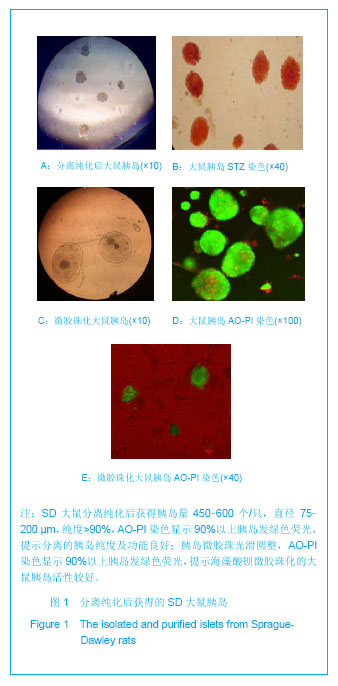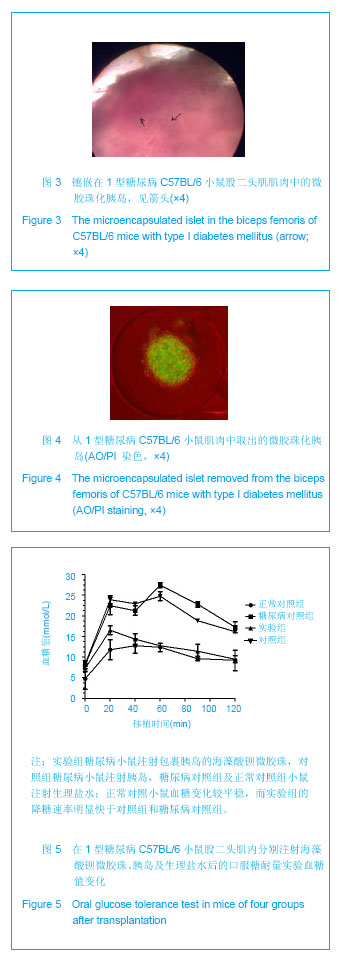| [1] Shapiro AM,Lakey JR,Ryan EA,et al.Islet transplantation in seven patients with type 1 diabetes mellitus using a glucocorticoid-free immunosuppressive regimen. N Engl J Med.2000;343(4): 230-238.[2] Shapiro AM,Ricordi C,Hering B,et al.International trial of the Edmonton protocol for islet transplantation.N Engl J Med. 2006;355(13): 1318-1330.[3] Ryan EA,Paty BW,Senior PA,et al.Five-year follow-up after clinical islet transplantation. Diabetes.2005;54(7): 2060-2069.[4] Ricordi C,Strom TB.Clinical islet transplantation: advances and immunological challenges.Nat Rev Immunol.2004;(4): 259-268.[5] Tokodai K,Goto M,Inagaki A,et al.C5a-inhibitory peptide combined with gabexate mesilate prevents the instant blood-mediated inflammatory reaction in a rat model of islet transplantation. Transplant Proc. 2010;42(6):2102-2103.[6] Ngoc PK,Phuc PV,Nhung TH,et al.Improving the efficacy of type 1 diabetes therapy by transplantation of immunoisolated insulin-producing cells.Human Cell.2011;24(2):86-95.[7] Vériter S,Mergen J,Goebbels RM,et al.In vivo selection of biocompatible alginates for islet encapsulation and subcutaneous transplantation. Tissue Eng Part A.2010; 16(5):1503-1512.[8] Dufrane D,Goebbels RM,Gianello P. Alginate macroencapsulation of pig islets allows correction of streptozotocin-induced diabetes in primates up to 6 months without immunosuppression. Transplantation. 2010;90(10): 1054-1062.[9] Lim F,Sun AM. Microencapsulated islets as bioartificial endocrine pancreas. Science.1980;210(4472): 908-910.[10] Lanza RP,Hayes JL,Chick WL.Encapsulated cell technology. Nat Biotech. 1996;14(9): 1107-1111.[11] O’Sullivan ES,Vegas A,Anderson DG,et al.Islets transplanted in immunoisolation devices: a review of the progress and the challenges that remain. Endocrine Reviews.2011;32(6): 827-844.[12] Uonaga T,Toyoda K,Okitsu T,et al.FGF-21 enhances islet engraftment in mouse syngeneic islet transplantation model. Islets.2010;2(4):247-251.[13] Vergani A,D'Addio F,Jurewicz M,et al.A novel clinically relevant strategy to abrogate autoimmunity and regulate alloimmunity in NOD mice.Diabetes.2010;59(9):2253-2264.[14] Xu YY,Fu HX,Wang ZM,et al.Zhongguo Xiufu Chongjian Waike Zazhi.2010;24(4):406-409.徐艳艳,傅红兴,王浙明,等. 大鼠胰岛分离纯化技术的改良及活性研究[J]. 中国修复重建外科杂志,2010,24(4):406-409.[15] Hu XP,Ding YS,Qian TL.Zhongguo Dangdai Yiyao.2012; 19(14): 27-30.胡先平,丁亚山,钱滔来.消化时间对大鼠胰岛分离纯化产量的影响[J].中国当代医药,2012,19(14):27-30.[16] Wang YF,Wang HL,Luo SQ.Zhongguo Zhuzhi Gongcheng Yanjiu Yu Linchuang Kangfu.2011,15(44):8247-8250. 王雁飞,王洪林,罗诗樵.糖尿病小鼠理想的胰岛移植部位[J].中国组织工程研究与临床康复,2011,15(44):8247-8250.[17] Vaithilingam V,Oberholzer J,Guillemin GJ,et al.The humanized NOD/SCID mouse as a preclinical model to study the fate of encapsulated human islets.Rev Diabet Stud.2010; 7(1):62-73.[18] Christoffersson G,Henriksnäs J,Johansson L,et al.Clinical and experimental pancreatic islet transplantation to striated muscle: establishment of a vascular system similar to that in native islets. Diabetes.2010;59(10):2569-2578.[19] Korsgren O,Nilsson B,Berme C,et al.Current status of clinical islet transplantation.Transplantation.2005;79(10):1289-1293.[20] Rafael E,Tibell A,Ryden M,et al.Intramuscular autotransplantation of pancreatic islets in a 7-year-old child: a 2-year follow-up.Am J Transplant.2008;8:458-462.[21] Zhang SL,Jiang ZS,Xing WJ,et al.Zhonghua Qiguan Yizhi Zazhi.1998;19(1):45-47.张胜兰,姜兆顺,邢万佳,等.改良的微囊化新生猪胰岛细胞移植治疗I型糖尿病八例报告[J].中华器官移植杂志,1998,19(1): 45-47.[22] Qiou LY. Dongbei Nongye Daxue.2007: 19.邱丽媛.肝细胞包裹用微囊材料的研制及其治疗大鼠肝衰竭模型的实验研究[D].东北农业大学,2007: 19.[23] Li CH,XueYL,LuoY,et al.Zhongguo Mianyixue Zazhi.2000; 16(5):259-261.李崇辉,薛毅珑,罗芸,等.APA 微囊对免疫细胞和细胞因子隔离效应的研究[J].中国免疫学杂志,2000,16(5):259-261.[24] Dufrane D,van Steenberghe M,Goebbels RM,et al.The influence of implantation site on the biocompatibility and survival of alginate encapsulated pig islets in rats. Biomaterials. 2006;27(17):3201.[25] Dufrane D,Goebbels RM,Saliez A,et al.Six-month survival of microencapsulated pig islets and alginate biocompatibility in primates: Proof of concept. Transplantation.2006;81:1345.[26] Orive G,Hernández RM,Rodríguez Gascón A,et al.Drug delivery in biotechnology: present and future. Curr Opin Biotechnol.2003;14(6): 659-664.[27] Chen ET,Yang XJ,Ye P, et al. Zhongguo Zhuzhi Gongcheng Yanjiu yu Linchuang Kangfu.2009;13(3):561-565.陈儿同,杨晓昀,叶萍,等.微囊胰岛移植的实验研究进展[J].中国组织工程研究与临床康复,2009,13(3):561-565.[28] Sakata N,Sumi S,Yoshimatsu G,et al.Encapsulated islets transplantation: Past, present and future.World J Gastrointest Pathophysiol.2012;3(1): 19-26. |



.jpg)
.jpg)